I search for the realness, the real feeling of a subject, all the texture around it … I always want to see the third dimension of something … I want to come alive with the object.”
– Andrew Wyeth, American realist painter
Buenos Aires – As I mentioned last week, our cocina de vanguardia class this week was focused on presenting a single (or actually, separately, several) ingredient in multiple textures, based on the techniques we looked at in the first trio of classes. It’s an interesting exercise – our instructors emphasized that it was unlikely that most of these would be served as a single dish in a restaurant setting, but I have to admit, a couple of them really could be, and probably would go over quite well. A couple of them, not so much. There weren’t any new techniques to talk about, so this is almost totally about presentation.
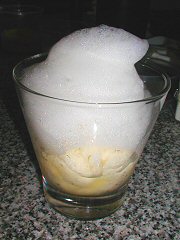 Leading off the pack was probably my least favorite – a simple, reinterpreted margarita. It wasn’t even that much of a reinterpretation, just using one simple touch of our bubble techniques. The base was a simple frozen margarita – lemon juice, tequila, cointreau, some simple syrup, and a touch of water added – it was all blended together and then frozen, and served more or less as a scoop of semi-frozen alcohol based sorbet (the alcohol prevents it from freezing completely solid, and gives you the texture you’re looking for). The touch of bubbles – an aire de sal, or salt air – a simple solution of saltwater with a little soy lecithin added to stabilize the bubbles – foamed with a hand blender and spooned over the top of the sorbet. Personally, I was never a fan of frozen margaritas anyway, preferring the classic liquid version of the drink with a nice salt rim. I’d also have done this with lime juice rather than lemon, but hey, it at least made for an interesting shot.
Leading off the pack was probably my least favorite – a simple, reinterpreted margarita. It wasn’t even that much of a reinterpretation, just using one simple touch of our bubble techniques. The base was a simple frozen margarita – lemon juice, tequila, cointreau, some simple syrup, and a touch of water added – it was all blended together and then frozen, and served more or less as a scoop of semi-frozen alcohol based sorbet (the alcohol prevents it from freezing completely solid, and gives you the texture you’re looking for). The touch of bubbles – an aire de sal, or salt air – a simple solution of saltwater with a little soy lecithin added to stabilize the bubbles – foamed with a hand blender and spooned over the top of the sorbet. Personally, I was never a fan of frozen margaritas anyway, preferring the classic liquid version of the drink with a nice salt rim. I’d also have done this with lime juice rather than lemon, but hey, it at least made for an interesting shot.
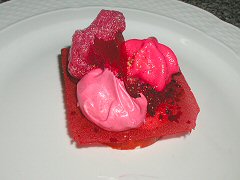 Now, it does happen that I love beets. And, I think this was my favorite of all the dishes prepared for the evening, and one I could actually see making an interesting, if odd, appetizer. At the base is a ring made of what is essentially “beet glass” – a mix of beets, sugar, and glucose that’s spread really thin on a silpat (silicone baking sheet), and then baked in a low heat oven until they make a sort of pliable, semi-translucent material. While still hot, strips (they used a stencil made of acetate to spread out the beet mixture) are made into a ring, about an inch in height and maybe two across, and then topped with a square of the same material (after both are allowed to harden). Atop that are a mix of various different things – a bit of beet gelatin, a cold beet foam, a baked beet merengue, a bit of beet granité, a cold yogurt foam (sour cream might be even more interesting), a beet air (same technique as the salt one above – just beet juice and some soy lecithin), and some scattered maldon salt, cracked black pepper, and red currants. Not bad actually – the merengue maybe a little too sweet for the rest of the dish, but that could be easily fixed.
Now, it does happen that I love beets. And, I think this was my favorite of all the dishes prepared for the evening, and one I could actually see making an interesting, if odd, appetizer. At the base is a ring made of what is essentially “beet glass” – a mix of beets, sugar, and glucose that’s spread really thin on a silpat (silicone baking sheet), and then baked in a low heat oven until they make a sort of pliable, semi-translucent material. While still hot, strips (they used a stencil made of acetate to spread out the beet mixture) are made into a ring, about an inch in height and maybe two across, and then topped with a square of the same material (after both are allowed to harden). Atop that are a mix of various different things – a bit of beet gelatin, a cold beet foam, a baked beet merengue, a bit of beet granité, a cold yogurt foam (sour cream might be even more interesting), a beet air (same technique as the salt one above – just beet juice and some soy lecithin), and some scattered maldon salt, cracked black pepper, and red currants. Not bad actually – the merengue maybe a little too sweet for the rest of the dish, but that could be easily fixed.
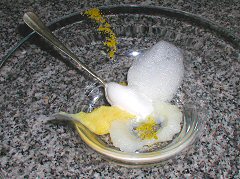 While I could see this dish being served as something like an intermezzo, or palate clearer, I can’t say it wowed me, though individually, the components could be put to great use on other dishes. It included small scoops of a lemon sorbet (I’m not clear why it needed gelatin and egg yolk added to make a sorbet, but so be it), a blanched pulp of the white pith of a lemon that had been sweetened but was still bitter, powdered dried lemon peel, a lemon air, and something called an emberré which I haven’t found a good translation of, but basically was a mix of lemon peel, sugar, water, lemon juice, all mixed into softened butter to flavor the butter – but it also meant a scoop of sweetened flavored butter on the plate – might be interesting (with less sugar) atop a piece of fish or chicken, as part of what was more or less a dessert, it was just weird.
While I could see this dish being served as something like an intermezzo, or palate clearer, I can’t say it wowed me, though individually, the components could be put to great use on other dishes. It included small scoops of a lemon sorbet (I’m not clear why it needed gelatin and egg yolk added to make a sorbet, but so be it), a blanched pulp of the white pith of a lemon that had been sweetened but was still bitter, powdered dried lemon peel, a lemon air, and something called an emberré which I haven’t found a good translation of, but basically was a mix of lemon peel, sugar, water, lemon juice, all mixed into softened butter to flavor the butter – but it also meant a scoop of sweetened flavored butter on the plate – might be interesting (with less sugar) atop a piece of fish or chicken, as part of what was more or less a dessert, it was just weird.
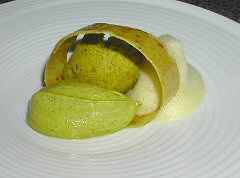 This was a pretty interesting dessert plate, and I could see serving it. It has a ring of a pistachio cookie, made fairly similarly to the beet glass above, a small cupcake made of a foamed pistachio, egg, sugar, and flour mix that’s foamed using a nitrous oxide canister – it’s foamed into a plastic cup and then cooked in the microwave for about 45-50 seconds, which just more or less solidifies the foam and makes a nice hot little cupcake. There’s a pistachio sorbet, some toasted pistachios, and a bit of a pistachio air. I liked this one quite a bit – there’s a nice interplay of textures – the cupcake was interesting, though in the end, I can’t say that texturally it was any different from a cupcake made in a traditional oven, just without any browning (and it wasn’t quite cooked through in the center, but another 10-15 seconds in the microwave it would have been). So the only real “cutting edge” technique was the bit of pistachio air. This was a lot more like a traditional dessert than most of what they’ve been showing us, maybe that’s why I liked it more?
This was a pretty interesting dessert plate, and I could see serving it. It has a ring of a pistachio cookie, made fairly similarly to the beet glass above, a small cupcake made of a foamed pistachio, egg, sugar, and flour mix that’s foamed using a nitrous oxide canister – it’s foamed into a plastic cup and then cooked in the microwave for about 45-50 seconds, which just more or less solidifies the foam and makes a nice hot little cupcake. There’s a pistachio sorbet, some toasted pistachios, and a bit of a pistachio air. I liked this one quite a bit – there’s a nice interplay of textures – the cupcake was interesting, though in the end, I can’t say that texturally it was any different from a cupcake made in a traditional oven, just without any browning (and it wasn’t quite cooked through in the center, but another 10-15 seconds in the microwave it would have been). So the only real “cutting edge” technique was the bit of pistachio air. This was a lot more like a traditional dessert than most of what they’ve been showing us, maybe that’s why I liked it more?
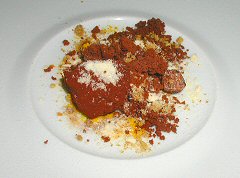 I have to admit, I just simply didn’t get this dish. It was referred to as tierra de chocolate, or chocolate earth, and it was, at least on the mouthfeel end of things, kind of like eating chocolate flavored dirt. Basically it’s a scattering of dried and pulverized peaches, a sort of semi-freddo of chocolate that was pulverized, a bit of crushed streusel topping, some caramelized hazelnuts that were likewise crushed, and a small ball of chocolate gelato rolled in bitter cocoa. The whole sensation was sort of dried out and not overly pleasant to eat – which made it hard to appreciate the flavors. I could have seen the first few things scattered around a nice quantity of the gelato, or accompanying something else entirely, but there just wasn’t enough of anything with a texture other than that of powder.
I have to admit, I just simply didn’t get this dish. It was referred to as tierra de chocolate, or chocolate earth, and it was, at least on the mouthfeel end of things, kind of like eating chocolate flavored dirt. Basically it’s a scattering of dried and pulverized peaches, a sort of semi-freddo of chocolate that was pulverized, a bit of crushed streusel topping, some caramelized hazelnuts that were likewise crushed, and a small ball of chocolate gelato rolled in bitter cocoa. The whole sensation was sort of dried out and not overly pleasant to eat – which made it hard to appreciate the flavors. I could have seen the first few things scattered around a nice quantity of the gelato, or accompanying something else entirely, but there just wasn’t enough of anything with a texture other than that of powder.
No idea what’s coming up next, they didn’t give us any hints… but stay tuned for me trying out a couple of the things we’ve learned on a private dinner this week…